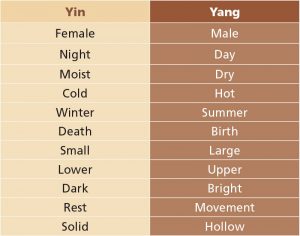The ancient Chinese were very much influenced by nature and its relationship to daily life. They saw the world as a harmonious and holistic entity rather than one that was functioning in isolation.
In their eyes, everything is interconnected and nothing is separate. The complicated phenomena of the universe is simplified through the concept of Yin and Yang.
The Yin & Yang Philosophy
The theory of Yin and Yang is the most fundamental concept of Traditional Chinese Medicine (TCM) and is used to understand complicated relationships in the body. The theory of Yin and Yang tries to describe the polar difference between seemingly contrary forces, its interconnectedness and interdependence in the natural world. These forces are opposite and yet complementary to each other, and share a mutually supporting relationship as part of a dynamic system, to teach us to live a well-balanced life. Without Yin, there would be no Yang, and without Yang, no Yin. At this point, it should be made clear that Yin and Yang do not correspond strictly to bad and good, as many in the West perceive.
The Yin and Yang concept also lies at the origins of many branches of classical Chinese science and philosophy, and a central principle of different forms of Chinese martial arts and exercise, such as tai chi, and qigong (Chi Kung) and of I-Ching divination. The Yin and Yang guideline is also incorporated in the way food should be consumed.
The Yin & Yang Symbol
Many would have noticed the black and white symbol of Yin and Yang without understanding the meaning. The outer circle of the symbol represents ‘whole’ or ‘everything’, while the black and white shapes within the circle represents the interaction of the primordial energies – Yin (Black) and Yang (White). Again, they are only representations as nothing in life can be separated as entirely black or even white. The shape of the Yin and Yang sections of the symbol, also gives you a sense of the continual movement of these two energies, Yin to Yang and Yang to Yin, causing everything to happen.
The Energies of Yin & Yang
Yin translates as “in the shade” and represents the moon, darkness, coldness, and passivity. Yang translates as “in the sunlight” and represents the sun, light, heat, and activity. The Yin-Yang philosophy emphasises the need for harmony, balance, and moderation in every aspect in life and nature in order to support the vital force of life, called qi. Qi is equated with “energy,” “air,” and “breath,” and when qi is in short supply or depleting, illness and disease occur.
A human body can be divided into exterior and interior sections; the temperature can be divided into hot or cold; time can be divided into day or night; animals can be divided into hot-blooded or cold-blooded, and so on. If you look intently, you will slowly be able to observe Yin & Yang at play.
The following are some of the more well-known examples of Yin and Yang:

Applying Yin and Yang to Chinese Medicine
Each organ in the body has an element of Yin and Yang within it. Some organs, such as the liver, are predominantly Yang; others, such as the kidneys, are Yin. Even though an organ may be predominantly Yin or Yang in nature, the balance of Yin and Yang is maintained throughout the body, because the sum total of Yin and Yang will be in balance.
It is important to note that the body is not always in an exact balance of Yin and Yang. Even when the body is healthy, there may be subtle shifts from one state to the other. When a person gets angry, for instance, the Yang state may dominate; when that person has calmed down and resumed to a peaceful state, Yin may become dominant.
In traditional Chinese medicine, illness is believed to be caused by an imbalance of Yin and Yang in the body. In an excess of Yin, the Yang qi would be damaged, leading to the development of a cold disease. Excess of Yang will likewise damage Yin qi and lead to a heat disease being developed.
Basic treatment of these diseases is aimed at replenishing depleted Yin or Yang, and it is through this process that the balance of Yin and Yang is re-established. Traditional Chinese medicine practitioners attempt to determine the exact nature of the imbalance, then correct it through a variety of approaches, including acupuncture, herbal remedies, exercise, and changes in diet and lifestyle. As the balance is restored in the body, so is the person’s health.
Yin and Yang & The Five Elements
There are five elements that need to be balanced in order to sustain a healthy qi. Fire, earth, metal, water, and wood correspond with five organs – heart, spleen, lungs, kidneys, and gallbladder, respectively. The five elements also correspond with the summer, late summer, autumn, winter, and spring; and the colours red, yellow, white, blue, and green; and taste such as bitter, sweet, pungent, salty, and sour, as well as other properties such as odours, sounds, times of day, and emotions.
The Yin-Yang concept can be thought of as simply a way to keep life in balance. We know we should balance work and success, fun, family, spirituality, stress, relaxation, eating, drinking, rest, exercise, etc, to keep ourselves stable. Too much of one thing and not enough of something else will likely disrupt the natural flow of our lives in some way, and thus take a toll on our wellbeing. For example, if you were so concerned with work and success that you lost sight of who you are and your values and relationships with loved ones, that aspect of your life would suffer. Conversely, if you were preoccupied with family and relationships, your work life could suffer, too.
The Yin and Yang philosophy has long helped many people who practiced it sustain well-balanced lives, which contributed to their enjoyment of long vigorous lives as well. Moderation in all aspects of life is key, and that goes beyond just diet. We can only live life to the fullest if we can nurture the different facets that make up the dynamic equilibrium of life. We may live long, healthy lives if we can learn and understand the concept of balance.


